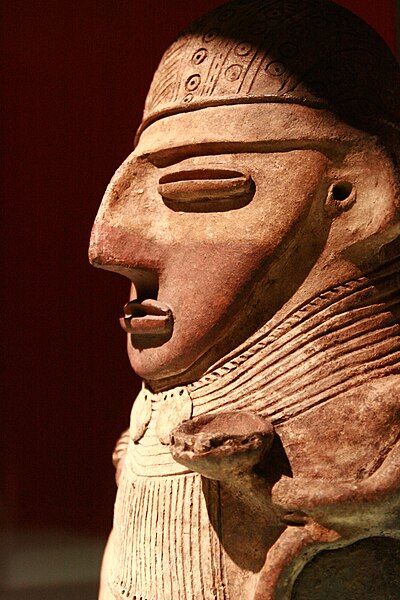El Dorado is commonly associated with the legend of a gold city, kingdom, or empire purportedly located somewhere in the Americas. Originally, El Hombre Dorado or El Rey Dorado, was the term used by the Spanish in the 16th century to describe a mythical tribal chief (zipa) or king of the Muisca people, an indigenous people of the Altiplano Cundiboyacense of Colombia, who as an initiation rite, covered himself with gold dust and submerged himself in Lake Guatavita.
The zipa, a mythical tribal chief of the native Muisca people, was said to cover his body in gold dust, and from his raft offer treasures to the Guatavita goddess in the middle of the sacred lake. This old Muisca tradition became the origin of the legend of El Dorado. This Muisca raft figure is on display in the Gold Museum, Bogotá, Colombia.
Nieuwe caerte van het Wonderbaer ende Goudrjcke Landt Guiana by Jodocus Hondius (1598) shows the city of Manoa on the northeastern shore of Lake Parime
Trinidad and Tobago stamp featuring the 'Discovery of Lake Asphalt by Raleigh, 1595'
The Muisca are an indigenous people and culture of the Altiplano Cundiboyacense, Colombia, that formed the Muisca Confederation before the Spanish conquest. The people spoke Muysccubun, a language of the Chibchan language family, also called Muysca and Mosca. They were encountered by conquistadors dispatched by the Spanish Empire in 1537 at the time of the conquest. Subgroupings of the Muisca were mostly identified by their allegiances to three great rulers: the hoa, centered in Hunza, ruling a territory roughly covering modern southern and northeastern Boyacá and southern Santander; the psihipqua, centered in Muyquytá and encompassing most of modern Cundinamarca, the western Llanos; and the iraca, religious ruler of Suamox and modern northeastern Boyacá and southwestern Santander.
Muisca raft (1200–1500 CE) representation of the initiation of the new zipa at the lake of Guatavita
View of the Eastern Ranges of the Colombian Andes Lake Tota is clearly visible
Petroglyphs of El Abra (~11,000 BCE)
A Muiscan ceramic figure.






